There are several smaller temples to explore within the Wat Saket monastery-temple complex besides the Golden Mount and the main shrines. A couple of them are located at the base of the Golden Mount, each dedicated to different auspicious aspects of the Buddha. Since I was passing by anyway, I took the opportunity to visit them. It was not a problem at all since both places have one single large room where the central Buddha figure is located.
 Buddhist shrine dedicated to the Lucky Buddha
Buddhist shrine dedicated to the Lucky Buddha
 Buddhist shrine dedicated to the Fortune Buddha
Buddhist shrine dedicated to the Fortune Buddha
Nearby, there is a tree where petitioners hang golden leaves on which they have inscribed their wishes and aspirations.
 Tree for hanging wishes
Tree for hanging wishes
Here I finished the tour of the Wat Saket monastery-temple complex and I started to return to the old centre of Bangkok where I was staying, following the same path I took to get here in the first place. However, this time, I paid attention to some of the buildings surrounding this temple. Directly across from the entrance to the temple complex, there are numerous workshops that deal with woodwork. I assume that the people who own these workshops/stores also live above them.
 Bangkok, a detail
Bangkok, a detail
Soon I reached one of the major boulevards that Bangkok abounds with, while the enormous traffic jam in this large city is a common sight.
 Bangkok, a detail
Bangkok, a detail
Since I was a bit tired due to the change in climate and the insufficient sleep, I headed towards the hotel. However, as there was another important temple nearby, I took the opportunity to go there. This is Wat Bowonniwet, often referred to as Wat Bowon, which is certainly shorter and simpler. The monastery was founded in 1826 and today this complex is densely filled with various structures, making it challenging to capture its parts well by a regular photo-camera (or maybe I was just too tired to search for good angles). Therefore, I went straight to the ubosot, the main structure within the temple.
 Wat Bowonniwet, entrance into the ubosot
Wat Bowonniwet, entrance into the ubosot
This temple is highly significant and respected in Thailand, primarily because of its association with the royal family. The tradition here expects men to spend at least a part of their lives, starting from the age of 20, as Buddhist monks and this applies to members of the royal family as well. King Mongkut, also known as Rama IV (b/r 1804/1851-1868), lived here as a monk for several years and even served as the abbot of this monastery. However, in 1851, he voluntarily left the monastic life and assumed the throne from his half-brother, King Rama III, who passed away that year.
Here, both King Rama IX (b/r 1927/1946-2016) and King Rama X (the king of Thailand during my stay in this country), born in 1952, spent some time as monks.
The temple also houses the headquarters of a highly significant monastic sect that belongs to the Thai Buddhist tradition.
As for the ubosot, you can see a Buddha figure from the 13th century surrounded by disciples (standing figures around the Buddha), while behind the main statue, there is another Buddha figure. The ashes of King Rama IX are placed beneath these Buddha statues.
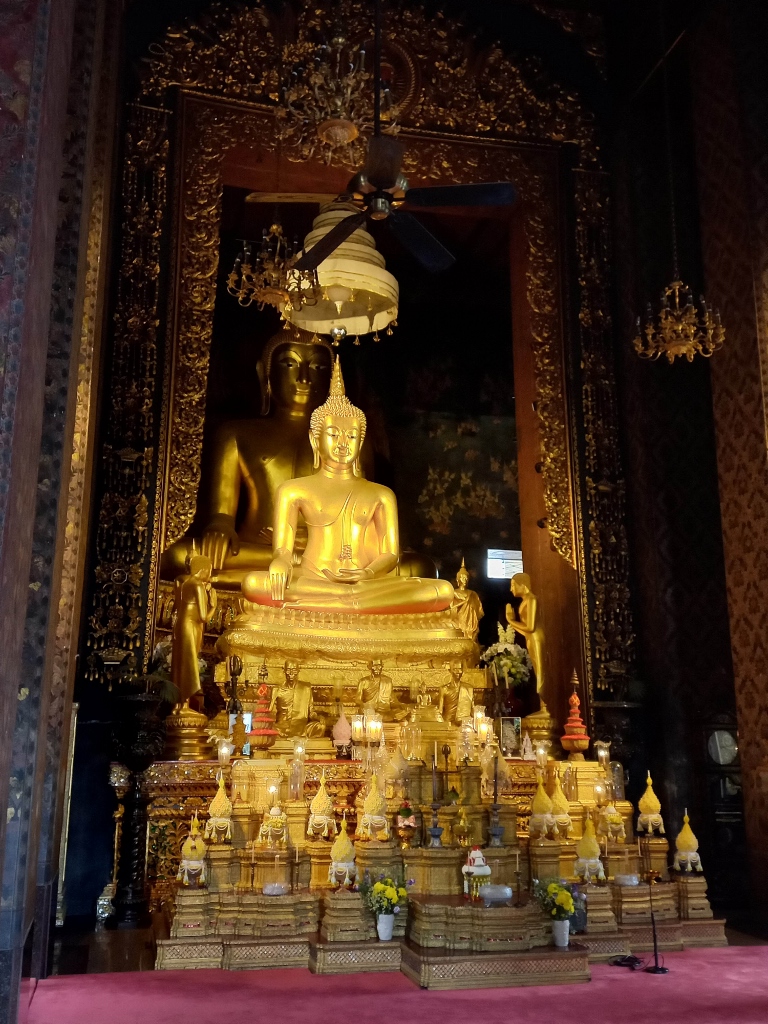 Wat Bowonniwet, the ubosot
Wat Bowonniwet, the ubosot
In the ubosot, you can see very beautiful and interesting murals, but I wanted to take a short stroll around the temple complex before heading back to the hotel.
To start with, I captured some of the external details of the ubosot.
 Wat Bowonniwet, the ubosot
Wat Bowonniwet, the ubosot
The temple complex includes a couple of viharas, but they are closed to the public. As I’ve mentioned earlier, there are numerous other buildings too, but what particularly stands out is the large golden chedi that is approximately 50 metres tall.
 Wat Bowonniwet, a detail
Wat Bowonniwet, a detail
 Wat Bowonniwet, the chedi
Wat Bowonniwet, the chedi
 Wat Bowonniwet, the chedi and parts of the temple
Wat Bowonniwet, the chedi and parts of the temple
After this, I only went to buy some freshly squeezed mango and passion fruit juice and to take a short walk along the sidewalks in this part of the city, filled with shops selling food. Although this was happening in a part of Bangkok popular among foreign visitors, street food is extremely important in Thailand – not only for tourists but for everyone.
 Refreshment in Bangkok
Refreshment in Bangkok
 Street food in Thailand
Street food in Thailand
And then I finally retreated to my hotel room to rest for a while.
Later, I went for another walk in the neighbourhood, but this time I first crossed to the other side of the canal next to my hotel. It is one of the main canals in Bangkok and is, in fact, a remaining part of the moat that King Rama I (b/r 1737/1782-1809) had dug. With the construction of this moat in the form of a semi-circle on the east side, Bangkok became Rattanakosin Island, as on the west side, also in a semi-circle, flows the Chao Phraya River, as I’ve mentioned earlier.
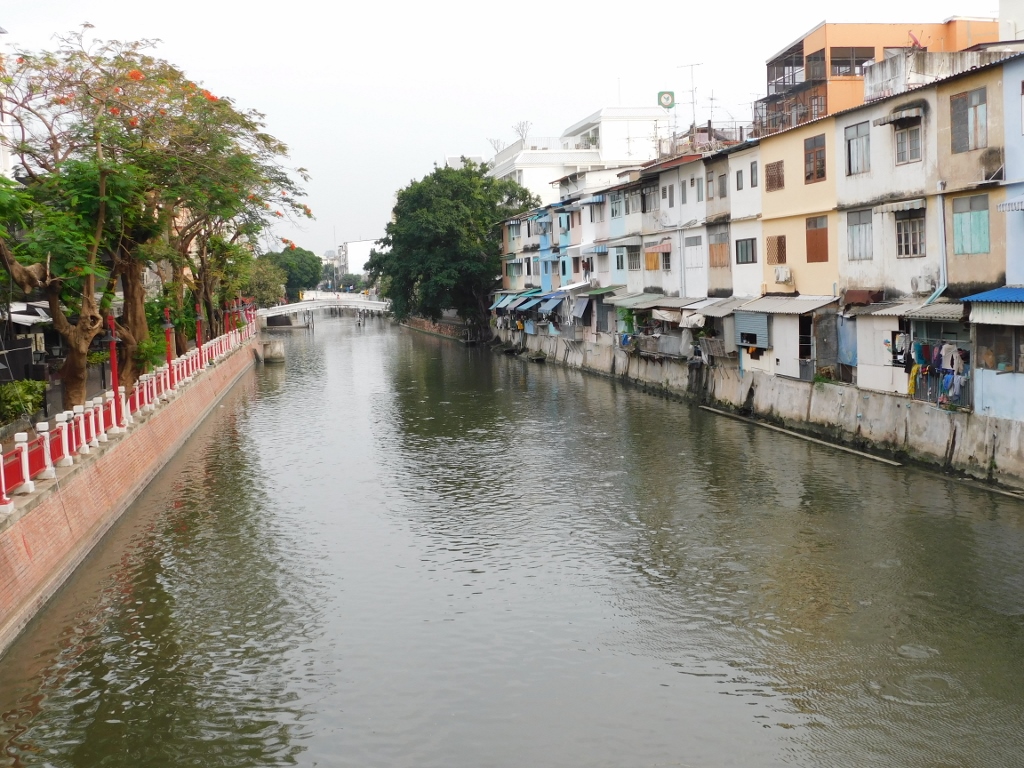 Canal in Bangkok
Canal in Bangkok
In addition to the hotel where I stayed, there are numerous buildings along the canal where the local population lives and they occasionally have to maintain their property.
 Bangkok, a detail
Bangkok, a detail
Already while sitting on the terrace of the hotel next to the canal, I noticed that the water often splashed with fish. Upon closer inspection, I saw some quite large specimens living there. However, the sight of the water convinced me that, just to be on the safe side, I shouldn’t order fish while in Bangkok.
 Fish and river water in Bangkok
Fish and river water in Bangkok
In the previous part of my travel stories about Thailand, I have already mentioned the fortifications that surrounded Bangkok from 1782 when King Rama I came to power and established his dynasty that still constitutes the Thai royal family today. On that occasion, Bangkok was declared the capital of the state, then was called the Kingdom of Rattanakosin at the time, although throughout history, the name Kingdom of Siam was more commonly used. The country got its present name, the Kingdom of Thailand, only in 1939.
By the way, I should mention that in the 19th century, during the colonial expansion of the European powers, Thailand managed to remain independent, unlike other states in Indochina, i.e., in Southeast Asia. Although it was under the strong influence of Great Britain, it stayed independent and was never a foreign colony. During that period, its kings succeeded in being good diplomats in relation to the foreign powers. However, internal problems did exist and in 1932, a coup took place, leading Thailand to become a constitutional monarchy.
With the establishment of the new dynasty at the end of the 18th century and the new capital as well, there was a need to ensure security. For this reason, fortifications were erected and to this day four forts and several shorter sections of the city walls remain. On this occasion, I visited the fort known as Phra Sumen Fort, located in close proximity to the Chao Phraya River.
 Phra Sumen Fort
Phra Sumen Fort
Between the fort and the river, there is a beautiful park. While not particularly large, it appears to be popular as a place for relaxation and practicing various activities.
 Phra Sumen Fort and Santi Chai Prakan Park
Phra Sumen Fort and Santi Chai Prakan Park
Within the park, established on the riverbank in 1999, there is a pavilion constructed in the Thai style, sharing the same name as the park.
 Santi Chai Prakan Pavilion
Santi Chai Prakan Pavilion
It is nice to come here not only for a relaxing time in the park, but also because it offers a beautiful view of the Chao Phraya River.
 The Chao Phraya river
The Chao Phraya river
By this time I was starting to get hungry. Not too much, but enough to look for a place to eat. In Bangkok, this is not difficult at all and I wasn’t particularly interested in seeking recommendations from my guidebooks. I simply sat down in a small, ordinary restaurant I passed by and ordered one of the famous Thai specialties, the Tom Yum Soup.
 Tom Yum Soup
Tom Yum Soup
In the end, I also had the famous Thai dessert, Mango Sticky Rice, which is essentially a pudding prepared with coconut milk and served with ripe mango, topped with additional coconut milk. There’s nothing not to like about it.
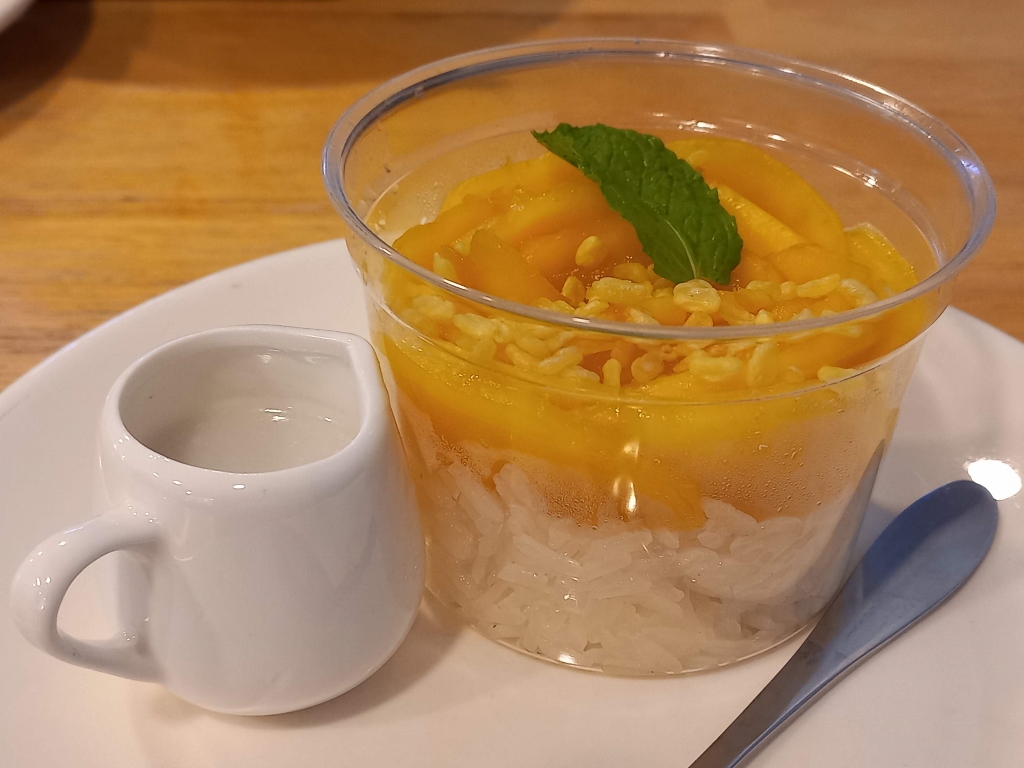 Mango Sticky Rice
Mango Sticky Rice
When I got back home, I made my version of this dessert. From experience I know that mangoes bought in supermarkets in areas with cold and temperate climates can never be as soft and juicy as mangoes that ripen where they grow. But I found a very satisfying substitute that is still fantastically delicious. I used peach compote that I made myself, but, in the end, I suppose that any soft fruit can go with rice prepared in this way. It’s actually a tasty and completely vegan version of the rice pudding that is traditionally made in Serbia using cow milk.
THAI STICKY RICE WITH PEACHES
- 200 g of rice
- 240 + 120 ml of water
- 400 ml of coconut milk
- 4 tbsp of sugar or honey
- a pinch of salt
- 4 peaches from compote
Rinse the rice, then add 240 ml of water and let it stand covered for an hour. Then add the remaining 120 ml of water and 200 ml of coconut milk and heat it up.
Immediately add 2 tablespoons of sugar or honey and a pinch of salt, then stir occasionally. When it starts to boil, reduce the heat to the lowest and cover. Stir occasionally. When it’s almost done, turn off completely and leave it covered.
Put the remaining 200 ml of coconut milk in a saucepan and add 2 tablespoons of sugar or honey. Heat it up, but there’s no need to boil this, just melt the sugar or honey.
To serve, spoon a “scoop” of the rice pudding, pour sweetened coconut milk over it and add diced peach cubes from the compote.
 My version of Peach Sticky Rice, served in a dish that I personally made
My version of Peach Sticky Rice, served in a dish that I personally made
After the late lunch in Bangkok, I started making my way back to the hotel. I was still tired from the overnight journey and the climate was also draining – it was hot that day with high humidity, though not as extreme as it would get towards the end of my trip. Regardless, I wanted to go to bed early.
But I didn’t want to go back the same way and I also didn’t want to take a route that would take me round and round. So, using the map on my mobile phone, I tried to figure out a shortcut. That’s how I accidentally stumbled upon an area that looked like a massive inner courtyard filled with houses. I mean, the streets there weren’t the main roads filled with traffic; they seemed more like pedestrian streets. This allowed for numerous food stalls to be set up on the pavement, along with plastic tables and chairs. The food choices were very tempting, but I had just eaten, so I promised myself I would come back here intentionally to try the food some other time.
 Food street in Bangkok
Food street in Bangkok
 Part of Bangkok where people can relax along simple, but nice food
Part of Bangkok where people can relax along simple, but nice food
But when I reached the end of this street I was on at the moment, which was a dead-end, I realised that I would need to detour for at least another half a kilometre, following the regular route, in order to reach Khao San Road, one of the main tourist streets that I needed to get to because it would lead me easily to the hotel where I was staying. As I’ve mentioned, I was tired and really didn’t feel like walking more than necessary. So, I opted for a little adventure and besides it helped me that earlier that same morning in Bangkok I had used a shortcut designated for pedestrians. Moreover, it was the perfect way for me not to feel like a tourist but rather someone who ‘knows’ the city.
I first walked along a wider path that led directly towards a building at the end.
 Paths less travelled
Paths less travelled
When I reached the end of the path and the building, it turned out that there was indeed an alley. For those who were not familiar with the local passages, there was a sign on one wall clearly indicating the way to go, so I followed it.
 Paths less travelled
Paths less travelled
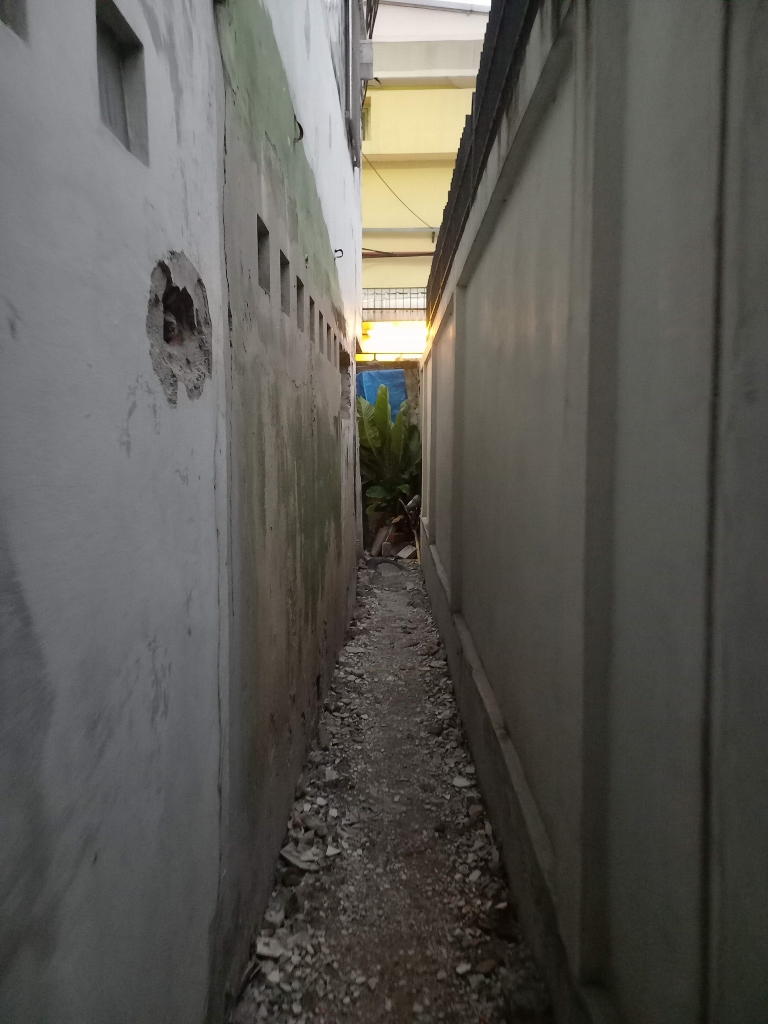 Paths less travelled
Paths less travelled
I must admit that this really felt surreal: on the one hand, I didn’t feel completely comfortable – it was dusk, I was alone and I hadn’t seen anyone around. On the other hand, paradoxically, I felt quite calm and safe. When I passed through this deserted and narrow part, I reached an area filled, as it seemed to me, with ‘street food kitchens’ that had just closed and their owners were getting ready to rest for the day.
 Paths less travelled
Paths less travelled
 Paths less travelled
Paths less travelled
And then I emerged onto one of the main streets, fully alive with traffic, people and the general hustle and bustle, while not far away was that street well-known among tourists – Khao San Road.
 Khao San Road in the evening
Khao San Road in the evening
Although I no longer ventured into any alleys, I still walked through less crowded, but equally active streets. Food was everywhere, as were people preparing and enjoying it. Nevertheless, I was quite eager to return to the hotel.
 Bangkok at night
Bangkok at night
However, I didn’t go to bed right away. As I’ve mentioned earlier, it turned out that my cousin Nikola was also in Bangkok these days, so we made arrangements and he came to my hotel for a beer. We had a wonderful chat and we would have continued, but he had to leave at some point since he and his girlfriend had an early flight the next day.
The next day I also had a potential meeting, this time with the son of my friend, who practically had been living in Bangkok for years. However, it turned out that something came up for Luke, so we postponed the meeting until the end of my trip. I had anyway made plans for morning that included a visit to the northern parts of Bangkok (compared to where I was) and my goal was a famous temple – Wat Benchamabophit. According to one of my guidebooks, which was quite outdated, there were also a couple of other interesting buildings in that part of the city. As it turned out, those buildings do exist, but they were temporarily closed, so after visiting the temple, I could only take a leisurely stroll in a wide circle around that area.
To start with, I decided to follows some side streets and alleys of Bangkok.
 Bangkok, a detail
Bangkok, a detail
However, sooner or later, one reaches larger and busier streets. I also crossed a canal called Khlong Phadung Krung Kasem, which was excavated in 1851 to serve as a new moat compared to the one that formed the artificial Rattanakosin Island, where the centre of Bangkok was located. As the city developed and expanded, the need arose to create this new moat, which was excavated approximately 1 km away from the original one.
 Bangkok, a detail
Bangkok, a detail
Everywhere in Bangkok where there are crowds and lots of people, there is also food. Or it’s the other way around. In any case, my route led me past a series of food stalls and here are just a couple of photos on that topic.
 Food stands in Bangkok, a detail
Food stands in Bangkok, a detail
 Food stands in Bangkok, a detail
Food stands in Bangkok, a detail
A few hundred metres further, I reached a wide avenue and headed towards the temple I wanted to visit. In that part of Bangkok, there are several large buildings and compounds that have either a police or military function. This is not surprising, given that the royal residence complex is nearby. Among other things, I passed by the headquarters of a division of the king’s guard and it was interesting to see a sign that speaks to whom they serve: “Country, Religion, Monarchy, and People.” In that order. Well, at least I found that interesting.
I also passed by the enormous Ananta Samakhom Throne Hall that was previously open to the public as a museum, but has been closed since 2017 until further notice.
 The Ananta Samakhom Throne Hall
The Ananta Samakhom Throne Hall
This enormous structure is part of the Dusit Palace that encompasses over ten royal residences and numerous gardens. One of the royal villas within this enclosed area was mentioned by that old guidebook as an exceptional building. However, it turned out that the Vimanmek Mansion was completely dismantled in 2019 to repair its foundations. The plan is to reassemble the villa later in the same location. I don’t know if it will be reopened to the public at that time.
As for the Ananta Samakhom Throne Hall, it was built in the early 20th century by the order of King Chulalongkorn or Rama V (b/r 1853/1868-1910). In the middle of the vast open space between the hall and the avenue I was walking along, I could see an equestrian statue of King Chulalongkorn. I captured this through a large ornate gate, while on the other side I could also see the entrance to another grand avenue adorned with royal portraits.
 Bangkok, a detail
Bangkok, a detail
And in the sky above, I could spot several storks gracefully flying over this area.
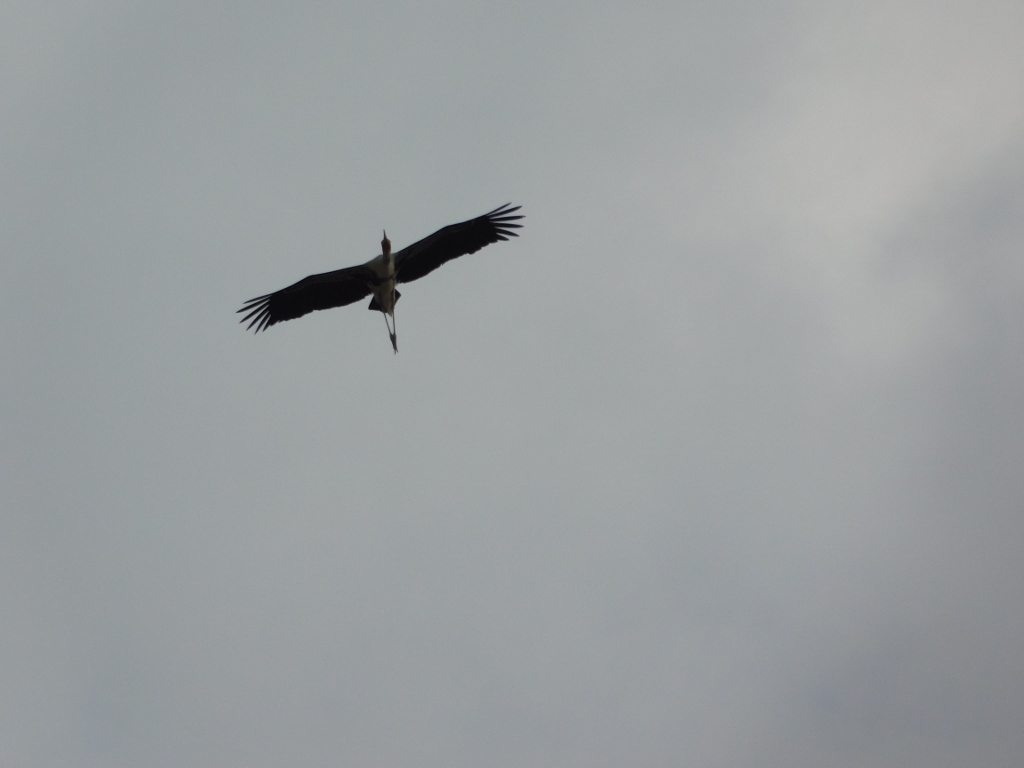 Stork above Bangkok
Stork above Bangkok
I was a bit puzzled by these storks in the middle of the enormous city, but I didn’t know anything about them, so I just continued on to the nearby Wat Benchamabophit Temple.